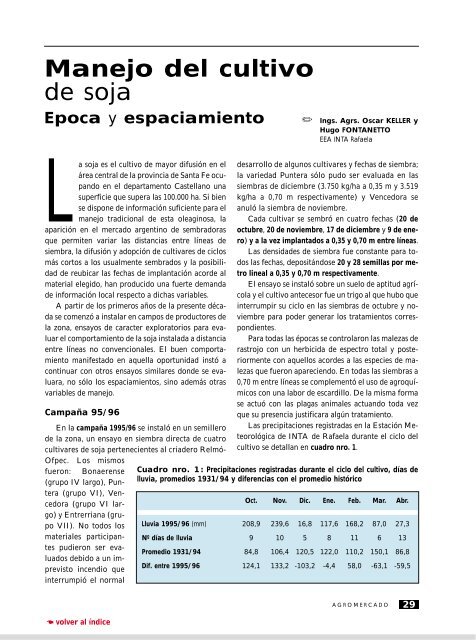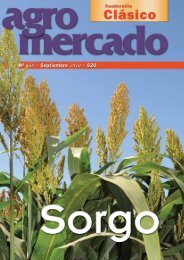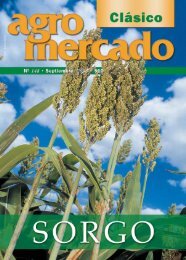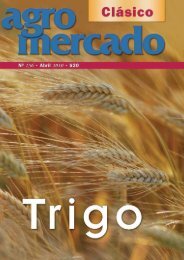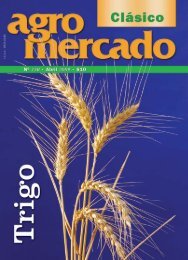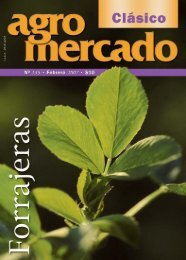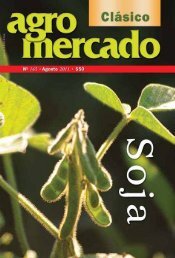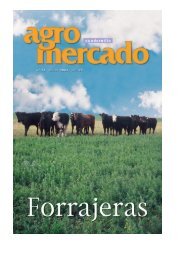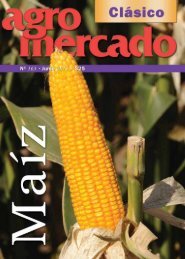Volver al menú principal de Soja - Revista Agromercado
Volver al menú principal de Soja - Revista Agromercado
Volver al menú principal de Soja - Revista Agromercado
You also want an ePaper? Increase the reach of your titles
YUMPU automatically turns print PDFs into web optimized ePapers that Google loves.
Manejo <strong>de</strong>l cultivo<br />
<strong>de</strong> soja<br />
Epoca y espaciamiento<br />
La soja es el cultivo <strong>de</strong> mayor difusión en el<br />
área centr<strong>al</strong> <strong>de</strong> la provincia <strong>de</strong> Santa Fe ocupando<br />
en el <strong>de</strong>partamento Castellano una<br />
superficie que supera las 100.000 ha. Si bien<br />
se dispone <strong>de</strong> información suficiente para el<br />
manejo tradicion<strong>al</strong> <strong>de</strong> esta oleaginosa, la<br />
aparición en el mercado argentino <strong>de</strong> sembradoras<br />
que permiten variar las distancias entre líneas <strong>de</strong><br />
siembra, la difusión y adopción <strong>de</strong> cultivares <strong>de</strong> ciclos<br />
más cortos a los usu<strong>al</strong>mente sembrados y la posibilidad<br />
<strong>de</strong> reubicar las fechas <strong>de</strong> implantación acor<strong>de</strong> <strong>al</strong><br />
materi<strong>al</strong> elegido, han producido una fuerte <strong>de</strong>manda<br />
<strong>de</strong> información loc<strong>al</strong> respecto a dichas variables.<br />
A partir <strong>de</strong> los primeros años <strong>de</strong> la presente década<br />
se comenzó a inst<strong>al</strong>ar en campos <strong>de</strong> productores <strong>de</strong><br />
la zona, ensayos <strong>de</strong> caracter exploratorios para ev<strong>al</strong>uar<br />
el comportamiento <strong>de</strong> la soja inst<strong>al</strong>ada a distancia<br />
entre líneas no convencion<strong>al</strong>es. El buen comportamiento<br />
manifestado en aquella oportunidad instó a<br />
continuar con otros ensayos similares don<strong>de</strong> se ev<strong>al</strong>uara,<br />
no sólo los espaciamientos, sino a<strong>de</strong>más otras<br />
variables <strong>de</strong> manejo.<br />
Campaña 95/96<br />
En la campaña 1995/96 se inst<strong>al</strong>ó en un semillero<br />
<strong>de</strong> la zona, un ensayo en siembra directa <strong>de</strong> cuatro<br />
cultivares <strong>de</strong> soja pertenecientes <strong>al</strong> cria<strong>de</strong>ro Relmó-<br />
Ofpec. Los mismos<br />
fueron: Bonaerense<br />
(grupo IV largo), Puntera<br />
(grupo VI), Vencedora<br />
(grupo VI largo)<br />
y Entrerriana (grupo<br />
VII). No todos los<br />
materi<strong>al</strong>es participantes<br />
pudieron ser ev<strong>al</strong>uados<br />
<strong>de</strong>bido a un imprevisto<br />
incendio que<br />
interrumpió el norm<strong>al</strong><br />
☛<br />
volver <strong>al</strong> índice<br />
✏ Ings. Agrs. Oscar KELLER y<br />
Hugo FONTANETTO<br />
EEA INTA Rafaela<br />
<strong>de</strong>sarrollo <strong>de</strong> <strong>al</strong>gunos cultivares y fechas <strong>de</strong> siembra;<br />
la variedad Puntera sólo pudo ser ev<strong>al</strong>uada en las<br />
siembras <strong>de</strong> diciembre (3.750 kg/ha a 0,35 m y 3.519<br />
kg/ha a 0,70 m respectivamente) y Vencedora se<br />
anuló la siembra <strong>de</strong> noviembre.<br />
Cada cultivar se sembró en cuatro fechas (20 <strong>de</strong><br />
octubre, 20 <strong>de</strong> noviembre, 17 <strong>de</strong> diciembre y 9 <strong>de</strong> enero)<br />
y a la vez implantados a 0,35 y 0,70 m entre líneas.<br />
Las <strong>de</strong>nsida<strong>de</strong>s <strong>de</strong> siembra fue constante para todos<br />
las fechas, <strong>de</strong>positándose 20 y 28 semillas por metro<br />
line<strong>al</strong> a 0,35 y 0,70 m respectivamente.<br />
El ensayo se inst<strong>al</strong>ó sobre un suelo <strong>de</strong> aptitud agrícola<br />
y el cultivo antecesor fue un trigo <strong>al</strong> que hubo que<br />
interrumpir su ciclo en las siembras <strong>de</strong> octubre y noviembre<br />
para po<strong>de</strong>r generar los tratamientos correspondientes.<br />
Para todas las épocas se controlaron las m<strong>al</strong>ezas <strong>de</strong><br />
rastrojo con un herbicida <strong>de</strong> espectro tot<strong>al</strong> y posteriormente<br />
con aquellos acor<strong>de</strong>s a las especies <strong>de</strong> m<strong>al</strong>ezas<br />
que fueron apareciendo. En todas las siembras a<br />
0,70 m entre líneas se complementó el uso <strong>de</strong> agroquímicos<br />
con una labor <strong>de</strong> escardillo. De la misma forma<br />
se actuó con las plagas anim<strong>al</strong>es actuando toda vez<br />
que su presencia justificara <strong>al</strong>gún tratamiento.<br />
Las precipitaciones registradas en la Estación Meteorológica<br />
<strong>de</strong> INTA <strong>de</strong> Rafaela durante el ciclo <strong>de</strong>l<br />
cultivo se <strong>de</strong>t<strong>al</strong>lan en cuadro nro. 1.<br />
Cuadro nro. 1: Precipitaciones registradas durante el ciclo <strong>de</strong>l cultivo, días <strong>de</strong><br />
lluvia, promedios 1931/94 y diferencias con el promedio histórico<br />
Oct. Nov. Dic. Ene. Feb. Mar. Abr.<br />
Lluvia 1995/96 (mm) 208,9 239,6 16,8 117,6 168,2 87,0 27,3<br />
Nº días <strong>de</strong> lluvia 9 10 5 8 11 6 13<br />
Promedio 1931/94 84,8 106,4 120,5 122,0 110,2 150,1 86,8<br />
Dif. entre 1995/96 124,1 133,2 -103,2 -4,4 58,0 -63,1 -59,5<br />
AGROMERCADO<br />
29


